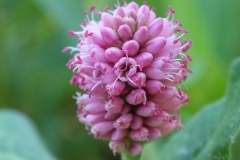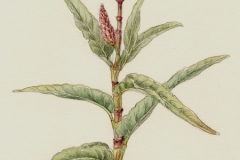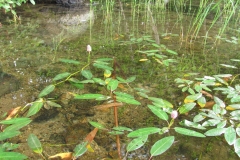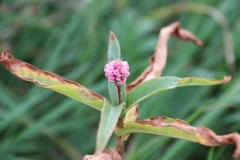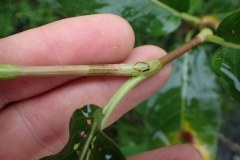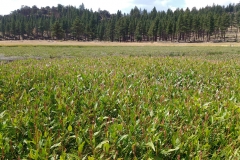Plant description
The herbaceous perennial plant has both terrestrial form as well as aquatic form. In form of terrestrial, it is 1 to 3 feet tall, more or less erect and either branched or sparingly branched. Leaves are alternate that occurs along entire length of terrestrial stems. Leaves are 2½-8 inches long and ½-3 inches across, narrowly lanceolate to lanceolate. Margins are entire or toothless. Upper surface of leaf is medium to dark green, glabrous to sparsely short pubescent. The lower surface is light green, glabrous and fine hairs occur along midvein and toward the leaf base. Leaf bases are wedge shaped or narrowly rounded and leaf tips are acute and slender. In aquatic form, stems of the plant are 6 feet long. The upper leaves float on the water surface. The leaf shape is lanceolate to oblong or elliptic to oblong having obtuse tips and rounded bases. The upper surface and lower surface of the leaves are glabrous. The terrestrial plants have light green or yellowish green stems which are glabrous to pubescent, relatively stout and terete. Flowers are 4-6 mm long and each flower contains 5 pink to rosy pink sepals, five stamens with white filaments and pink anthers. Flowers are perfect and sometimes unisexual. Sepals are oval spreading outward slightly when fully open. The plant blooms from mid-summer to autumn and lasts for 2 to 3 months. Seeds are broadly ellipsoid or ovoid, somewhat flattened and brown measuring 2 to 3.5 mm long. Roots are stoloniferous or rhizomatous from which clonal plants develop. Fibrous roots form from nodes of stems and produce clonal plants.
Leaves
Leaves are alternate, lanceolate to ovate and 8 inches x 3 inches with smooth margins, tapering to a pointed tip. Leaf base is tapered to rounded, slightly heart shaped with short stout stalk forming sheath at the stem. Upper leaf surface does not have dark triangular or crescent shaped blotch. Margins of leaf blades are smooth and undulating with rough forward curving short stiff hair. The surfaces are green. Upper surface may contain appressed hairs. The underside mid veins is conspicuous. The ocrea (leaf stem) is tan to dark brown, cylindric with truncate to oblique margins. The ocrea surface is smooth but with appressed dense hairs without glands.
Flowers
Flowers are bright reddish to pink arranged in 1 to 2 dense, elongated, cylindrical to egg shaped flower clusters measuring 1 to 10 cm long at the top of thick flower stalk. The flowers of cup shaped have 5 sepals about 4 to 5 mm long which connects at the base and 8 protruding stamens. The terrestrial variety bears cylindrical flower clusters about 4 cm long. Aquatic variety has egg shaped flower clusters that measures 4 cm long. Flowers are bright pink, 1/8-inch across with five tepals and long pink tipped stamens.
Fruit
Fruit is a shiny or dull, smooth and dark brown seed.
- Infusion made with leaves and stems are used for treating stomach pains or diarrhea in children.
- Roots are consumed raw or infusion made with dried roots is used for treating chest colds.
- Apply the poultice of fresh roots to the mouth for treating blisters.
Culinary uses
- Cook the leaves or consume it raw.
- Cook the young shoots.
References:
https://www.itis.gov/servlet/SingleRpt/SingleRpt?search_topic=TSN&search_value=823854#null
https://pfaf.org/user/Plant.aspx?LatinName=Persicaria+amphibia
http://ucjeps.berkeley.edu/eflora/eflora_display.php?tid=69778
https://www.illinoiswildflowers.info/wetland/plants/wt_smartweed.html
https://www.americansouthwest.net/plants/wildflowers/persicaria-amphibia.html
https://www.friendsofthewildflowergarden.org/pages/plants/smartweed_water.html
Comments
| Water smartweed Quick Facts | |
|---|---|
| Name: | Water smartweed |
| Scientific Name: | Persicaria amphibia |
| Colors | Dark-brown |
| Shapes | 2-3 mm, 1.6-2.6 mm wide, lens-shaped |
| Name | Water smartweed |
|---|---|
| Scientific Name | Persicaria amphibia |
| Common/English Name | Willow Grass, Longroot smartweed, Water knotweed, Water smartweed, Amphibious bistor, Swamp Smartweed, Swamp Knotweed, Water Heart’s-ease, Tanweed, Tansy Mustard, Devil’s Shoestring |
| Name in Other Languages | Arabic: Assâ er râ’ î; Chinese: Liang qi liao, Tian liao, Liang qi liao; Danish: Sumphirse, Vand-Pileurt; Dutch: Waterwilg, Veenwortel, Watersmerte; English: Amphibious knotweed, Amphibious bistort, Water smartweed, Amphibious persicaria, Water persicaria; Estonian: Vesi-kirburohi; Finnish: Vesitatar; French: Persicaire amphibie, Persicaire flottante, Renouée amphibie; German: Flöhkraut, Wasserknöterich, Sumpf-Knöterich; Italian: Persicaria anfibia; Norwegian Bokmål: Vasslirekne; Nynorsk, Norwegian: Vasslirekne; Polish: Rdest ziemnowodny; Spanish: Persicaria anfibia, Polígono anfibio; Swedish: Vattenpilört, Grodpilört; Turkish: Çoban dayaghi, Çoban deghinaghi |
| Plant Growth Habit | Perennial |
| Plant Size | 1.5 m tall |
| Stem | Prostrate to erect, 20-120 cm |
| Leaf | Alternate, 2 to 15 cm long, 1 to 6 cm wide |
| Flowering Season | Mid-summer into autumn |
| Flower | Bright reddish-pink, 1-10 cm long |
| Fruit shape & size | 2-3 mm, 1.6-2.6 mm wide, lens-shaped |
| Fruit color | Dark-brown |
| Seed | Dark brown, lentil-shaped, 2-3 mm long |



